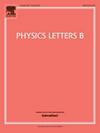Lattice simulation of nucleon distribution and shell closure in the proton-rich nucleus 22Si
IF 4.5
2区 物理与天体物理
Q1 ASTRONOMY & ASTROPHYSICS
引用次数: 0
Abstract
The proton-rich nucleus Si is studied using Nuclear Lattice Effective Field Theory with high-fidelity chiral forces. Our results indicate that Si is more tightly bound than Mg, thereby excluding the possibility of two-proton emission. The shell closure in Si is investigated through the evolution of the state in the neighboring nuclei. We then focus on the charge radius and spatial distribution information of Si, considering the novel phenomena that may emerge due to the small two-proton separation energy and the shell closure. We present the distribution of the 14 protons and 8 neutrons obtained from our lattice simulation, revealing insights into the spatial arrangement of the nucleons. Moreover, the spatial localization of the outermost proton and neutron suggests that Si is a doubly magic nucleus. Furthermore, we develop the pinhole method based on the harmonic oscillator basis, which gives insight into the nuclear structure in terms of the shell model picture from lattice simulations. Our calculated occupation numbers support that and are the shell closures and show that the orbital component is minor in Si.
富质子核中核子分布和壳层闭合的晶格模拟[公式省略]Si
利用具有高保真手性的核晶格有效场理论研究了富含质子的22Si核。我们的结果表明,22Si比20Mg的结合更紧密,从而排除了双质子发射的可能性。通过邻核2+态的演化研究了22Si中Z=14的壳层闭合。考虑到22Si的电荷半径和空间分布信息,考虑到由于双质子分离能量小和壳层闭合可能出现的新现象。我们展示了从晶格模拟中获得的14个质子和8个中子的分布,揭示了对核子空间排列的见解。此外,最外层质子和中子的空间定位表明22Si是一个双幻核。此外,我们开发了基于谐振子基的针孔方法,该方法可以从晶格模拟的壳模型图像中深入了解核结构。我们计算的占位数支持了Z=14和N=8是壳包层,并表明在22Si中π1s /2轨道分量很小。
本文章由计算机程序翻译,如有差异,请以英文原文为准。
求助全文
约1分钟内获得全文
求助全文
来源期刊

Physics Letters B
物理-物理:综合
CiteScore
9.10
自引率
6.80%
发文量
647
审稿时长
3 months
期刊介绍:
Physics Letters B ensures the rapid publication of important new results in particle physics, nuclear physics and cosmology. Specialized editors are responsible for contributions in experimental nuclear physics, theoretical nuclear physics, experimental high-energy physics, theoretical high-energy physics, and astrophysics.
 求助内容:
求助内容: 应助结果提醒方式:
应助结果提醒方式:


